With overcast skies and lower temps (mid-80’s) it was time to tackle the garden and trim down the indigos. I had been down from some surgery and after a month recovery I actually have some energy to tackle the garden and try to catch up. Both the Japanese Indigo and the Indigo Suffruticosa have been playing nicely together in the prime bed. The Suff can be a bully and shade out the JI. If my alternate indigo bed works out on the west side of the house my prime bed will go back to Japanese Indigo. In the meantime there is trimming to do. Here’s the start…
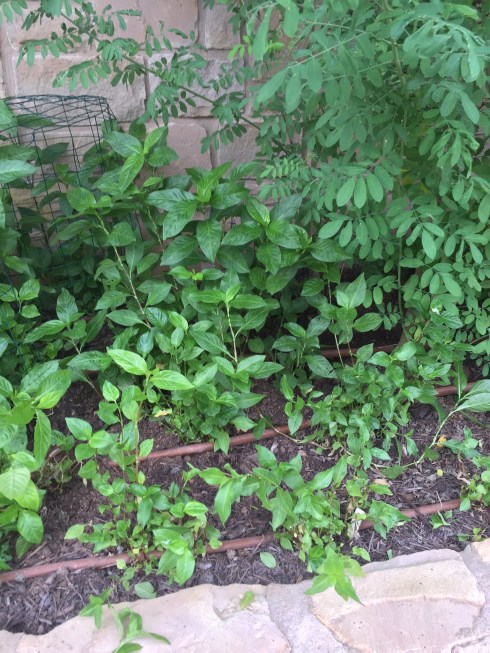
The cage is to keep the raccoons from digging for grubs around my Japanese Indigo. I ended up with eight bundles of JI to dry. These leaves will dry over the next week as our temps jump back up and be stored for more dried leaf dye experiments.
I used the shorter cuttings and trimmings to do some blender indigo. I couldn’t bear to let any indigo leaf go to waste!
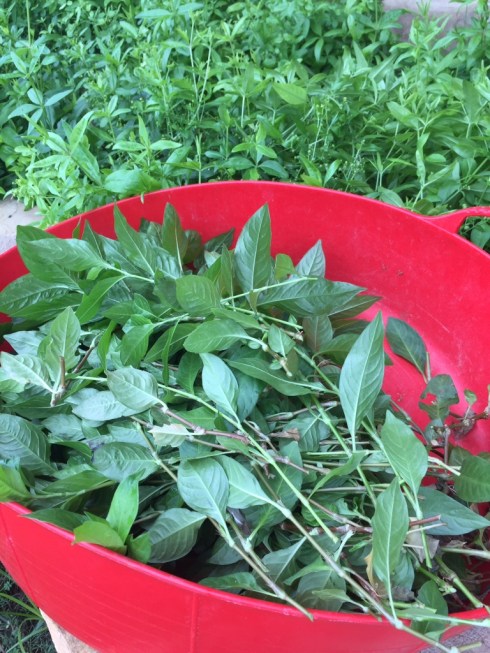
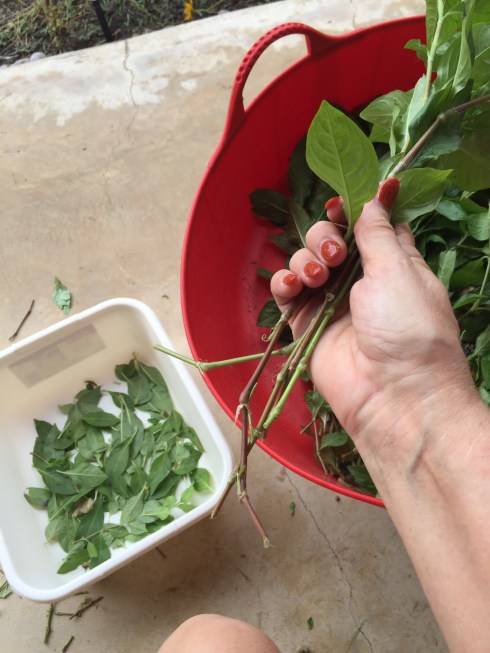
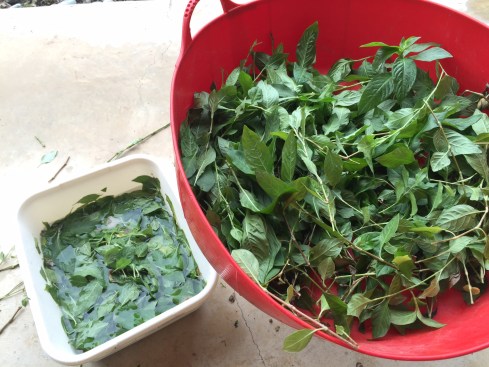
I keep the JI leaves in iced water until I could get to them. I then trimmed out my Indigo Suffrucitosa to put another batch into a soak.

That trimming yielded about 1700 grams of leaves. They’ve been tucked in a tall pot, given water and sat aside to soak a couple of days to free up the indigo from the leaves….rot it out!
There was another IS batch prepped this week and proved itself an indigo pot. I added slaked lime and some solar ground madder root I had on hand to help reduce the pot, looking back at yesterday I tested some napkins and the pot proved ready to work. Here’s yesterday’s results from Indigo Suffrucitosa reduced with rotten madder root with a ph kick of slaked lime.



Today I dipped a linen shirt I found in a Santa Fe thrift shop, it came out a great dark blue after two five minute dips and a hour oxidation between the dips.
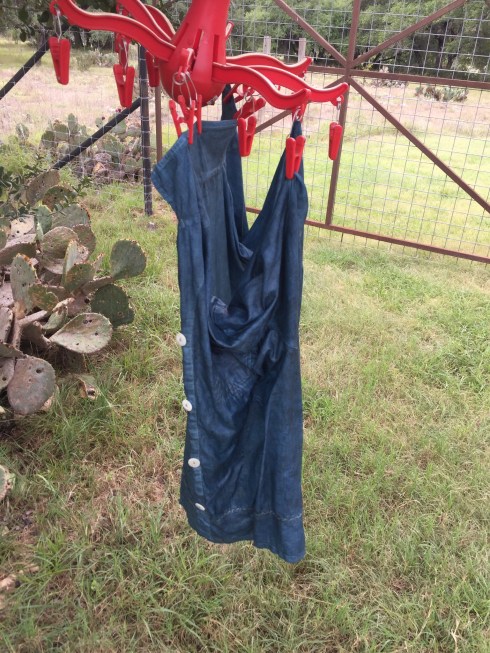
Turning my attention back to the iced Japanese Indigo I popped it thru the blender and filtered it to keep the mashed leaves out of my dye bath. I had an indigo shirt which had faded with washing so I wanted to freshen the color. It will show as green but will shift to indigo blue slowly. It is another white shirt I picked up at a thrift store that needed a new life.
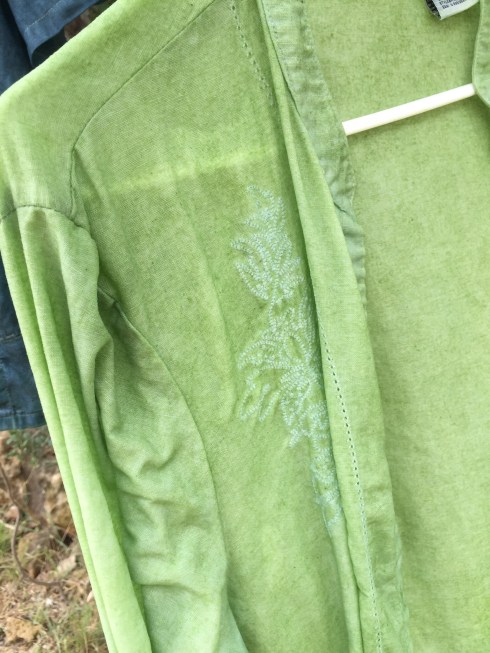
Finally, earlier this year I believe I posted my silk skeins that turned a mystery purple/lavender. I popped those in the blender indigo to overdue the lavender to shift to the more traditional indigo blue. Here’s the before & after!
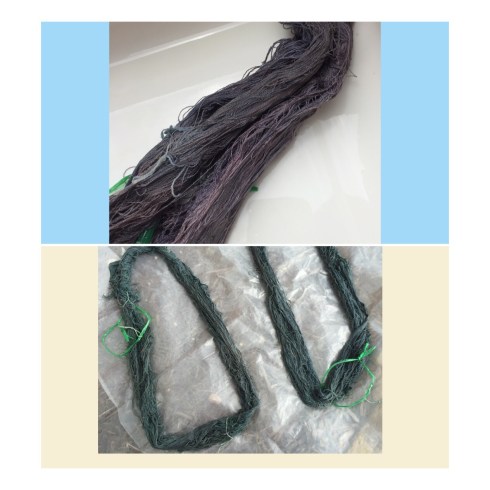
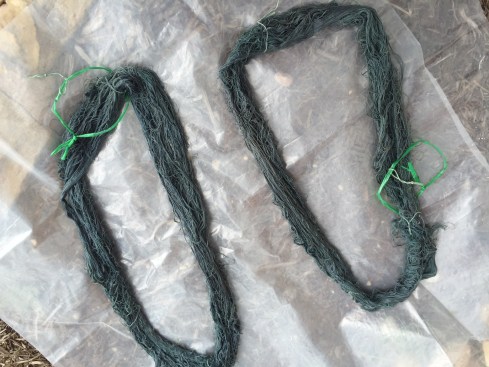
These skeins might go into the IS pot with some other skeins from last year. Layering the blues makes them so rich! Or I might stop with this blue. It depends on how they level out after washing.
So….from my Indigo Suffrucitosa on the left I get the deep blue and on the right I get my Japanese Indigo green. It will slowly shift to the indigo blue we know. All of my materials are oxidizing now to strengthen the indigo bond and I will neutralize all with vinegar bath tomorrow so the slaked lime high ph will not weaken the goods. A good day clearing the garden and catching up on some dyeing!

Wow, those are some powerful blues!
LikeLike
Thank you, I am very happy with darker blue after two dips. Tomorrow I rinse and find out if my pot was properly balanced!
LikeLike
Glad to hear you are back at it. My biggest question is did you have to do much watering of the plants? I know you have recently had a LOT of rain-too much even. Here, I can no longer justify the water usage so am a bit jealous of your fresh vat experiments. the yard looks great!
LikeLike
Thanks….When we built our house we put in drip irrigation. It pulls from our well which means we have a lot of limestone in it. Fortunately the indigo appears to like the higher ph water. So, at the start of the garden year I literally put out markers by each drip hole and put my Japanese Indigo seedlings directly by the water source. The drip runs 3 times a week and keeps the indigo happy. Even more important is shielding the indigo from the hot August sun. My prime bed has direct sun a very short time and partial sun the rest of the day so the JI is happy. Direct sun all day here in Texas translates to unhappy small Japanese Indigo.
LikeLike
This is from some of your seed. It got a late start, as I have been away a lot (for sad reasons) and left my seedlings to others’ care. Watering was mostly attentive, transplanting seedlings was not. The plants look healthy however, and have been getting daily rain. Maybe too much. I have a question about suffrucitosa. As a perennial shrub, how should I winter these potted plants? Apparently your grown shrubs survive your winters outdoors?
Well, I meant to post a photo of the plants, but can’t seem to do that. The IS are about a foot tall.
LikeLike
Sue, I don’t remember where you live so not sure how winter will treat your plants. All of mine are in central Texas ground and protected from NW winter cold. We do have short periods of freezing but warm up in between freezes. Perhaps try to protect the pots. Some of my 3 year old plants are 8 foot tall now. I am planning to run a dye pit soon to see if they still give good color. Younger two year old plants are still giving indigo. Have you tried clipping back your plants and going for blue yet?
LikeLike
I am near Nashville Tennessee. I could put the pots in the crawl space under the house. It would be warm enough there, but they would get no light. They must loose their leaves in winter, no? This year they are small enough I could bring them in the house. Eventually they will have to survive outside, or die. I have not harvested any leaves yet. The plants are still quite small.
LikeLike
Nice blues you’re getting from both sources! Indigo is such an adventure, because it can be different every time you use it, even when you try your damndest to keep the chemistry consistent every time. At least, that’s my experience.
LikeLiked by 1 person
Totally agree! Sometimes the batch is happy, sometimes it taunts you! Natural dyes teach you acceptance, patience and reconciliation at every step.
LikeLike
Do you dry after each dip or do a rinse or just do a 5min. dip than hang and redip?
LikeLike
I dip from 3-5 minutes depending on substrate and ph of bath. I let it oxidize for 30-60 minutes while the vat recovers and then redip as needed to build color. Indigo always lightens up when it dries, so when you look at the wet skeins you have to make a judgement call as to how dark you want to take it. I work with the fresh leaf so I have limited indigo from the leaves. I tend to set skeins aside and redip the skeins when the next leaf crop builds. Different timing when you use leaves opposed to the indigo powder we have access to in the marketplace. But principle is the same.
LikeLike
Have been trying to remember how best to wash, care for indigo fabric after dyed to keep the color (less fade and crock). Recall 1 instructor said store in dark place. How much ways of extracting, dying effects or length of dip or strength, temp. of vat…
LikeLike
A balanced vat in the beginning helps the longevity of your color. When a vat is “off”, not enough oxygen or wrong ph your indigo will crock. If you use too much powdered indigo and get it to stick to the yarn but the oxygenation is interrupted you’ll get crocking. Indigo bonds on the surface of the yarn, a substantive dye. Hence, it will come off in the long run. No matter what you do. Best to wash gently. I can’t speak to the keep it in the dark theory. Short many dips allow the bonding process to strengthen. One long dip just builds up a layer on the fiber and then layers of indigo on the indigo and that will crock.
LikeLike
Debbie, Thank you for your reply and info! Am still digesting it. Will keep adding a reducing agent and see how goes then maybe try alkalizing (any suggestions of pH meters to consider or avoid?). Am wanting to grow (only have JI seed), but we have snails and pill bugs, so did get 1 plant and it was topped the other day when 5″ tall. Here in Socal might be easier to grow Is.
LikeLike
I don’t use ph meters, I use ph paper from pro chemical https://prochemicalanddye.net/ph-paper.html
We have crickets in the spring here, so I start my JI in starter trays and keep them until AFTER crickets die down. Might be worth trying that. Remember the JI is an short annual, the SI is a shrub and gets tall, I have some that are 6″. They are well protected from west sun and north winds. I am testing some now on a west wall and neglect, but they do have irrigation.
LikeLike
Have you ever mixed your leaves and dyed with both JI and IS? I am going to try the blender method tomorrow. I don’t have much, hope to get a half ounce to an ounce of fresh leaves. Being able to use both would help with quantity. The JI plants are just starting to produce flower stalks, and I’d like to leave those stalks to see if I can get any seed for next year.
LikeLike